|

August 2004 and January 2005
Other anomalous finds from Peru add fuel
to this celestial fire. Kathy Doore is a researcher who has
travelled to Peru many times in connection with the
Ica Stones, and
runs the website
Labyrinthina.com
(2). Some time ago
she sent me some images of an example of an Ica Stone that appeared
to show anomalous celestial phenomena that could well be related to
a previous appearance of Nibiru. If these carved river stones are
authentic in displaying the artwork of an ancient people inhabiting
the lands of Peru, then this is certainly strong evidence. But I was
cautious initially, because other Ica Stones (and there are
literally tens of thousands of them) show dinosaurs and such like.
It all seemed a little far-fetched.
|
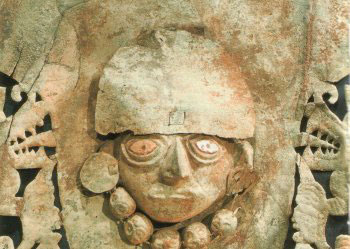 |
This image shows an Andean
silver headdress said to depict a ’warrior flanked by
two dragons’
(5). Note the 7 discs creating a necklace
around the warrior’s neck (the one to the far right is
damaged). If one takes the dragons to be fiery wings
flanking a central disc (and the warrior’s face is
clearly spherical) then we can see the classic Winged
Disc imagery emerge here.
This is Dark Star symbolism, made all the more poignant
by the inclusion of the seven discs; showing the seven
orbiting moons, two of which are major, five minor. The
two major moon discs correspond to the uraei of the
Egyptian Winged Discs. |
The primary investigator of the Ica Stones was the late
Dr Javier
Cabrera. He set about trying to collect, catalogue and analyze
patterns among the Stones, obtaining them for practically nothing
from Peruvians who claimed that they had excavated them.
Archaeological digs must be permitted officially in Peru, and this
led to certain problems of authenticating the finds when the
Peruvian media became involved: some of the people who were original
sources of the Ica Stones changed their stories when pressed by the
authorities and claimed to have created the tens of thousands of
stones over the course of several years.
The matter of the Ica Stones had already been dismissed by academic
archaeologists in general, and now was firmly debunked by the media.
Despite this, there remains a fascination for them. This is probably
because the accusation of ‘fraud’ flies in the face of common sense.
There are up to 50,000 of these stones in private collections around
the globe; the process of creating them would have amounted to an
industrial scale output. Yet they have always been worth next to
nothing individually, and for many years languished in rubbish piles
in the Ica museum. Furthermore, there was scientific evidence to
suggest that the engravings were indeed old, and certainly not
contemporary, as the frustrated Dr Cabrera explained:
“On January 28, 1969 I received word from
Eric Wolf that the results
of the laboratory analysis conducted by a Professor Frenchen and his
assistants at the University of Bonn were available. The stones were
andesite and were covered by a patina or film of natural oxidation
which also covered the etchings, permitting one to deduce that they
are very old.
“In view of the fact that the patina of oxidation that covered the
stones proved the general but not precise antiquity of the
engravings, and in view of the fact that precision could only be had
by using the comparative methods of stratigraphy and paleontology, I
requested authorization in April 1970 from the Patronato Nacionial
de Arqueologia to carry out excavations in the appropriate zone.
This institution alone had the power to authorize such excavations.
On July 16, 1970, my request was refused. Thus the only means of
dating the Engraved Stones of Ica was closed to me.”
(2)
In addition, several Ica Stones were discovered in unearthed tombs
in the Ica region by archeologists in the 1960s, self-evidently
authenticating these particular stones and bringing into question
the almost universal dismissal of the Ica Stones in general:
“In 1968, the archeologist Pezzia Assereto, who had accompanied
Agurto Calvo, published a book on the archeology of the province of
Ica, in which he makes note of the discovery:
"Agurto was able after
several attempts to find an engraved stone inside a tomb in the
sector of Toma Luz of the Hacienda Callango del Valle in Ica on 20
August 1966... After informing the Museo Regional of Ica of such an
important find, Agurto and I made another excavation on 11 September
of the same year, in the hill called Uhle of the sector of La Banda
in the Hacienda Ocucaje, and we found for the first time an engraved
stone inside a tomb of the Paracas culture, a thing I was not
expecting, but which proved, by association, the authenticity of
these artifacts"”
(2)
Even so, things are rarely black and white. It is entirely possible
that even if there are original, ancient Ica Stones dug out of the
ground or found in tombs, there may also be a large body of faked
Stones created by some of the locals hoping to cash in on the find.
In which case, how does one determine which of them are genuine and
which are faked, and how does one draw any firm conclusions from the
body of Stones as a whole? A similar predicament presents itself
when assessing the
Crop Circles prevalent each year in the English
countryside; no one thinks they are all ‘genuine’, but some
researchers consider it likely that some crop circles are truly
anomalous. This complex picture seems plausible, so we must tread
carefully when similarly considering the Ica Stones.
|
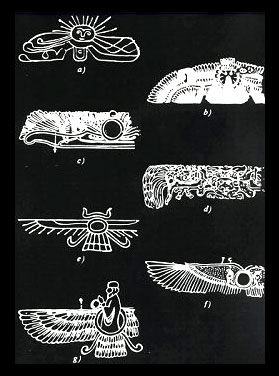 |
Comparing
Winged Discs from around the Globe:
a)
South American
b) Toltec
c) Aztec
d) Mayan
e) Babylonian
f) Egyptian
g) Iranian
From "Atlantis: The Seven Seals" by
Zoltan Andrew Simon (1983).(8) With thanks to
Greg Jenner
|
If entirely genuine, the Ica Stones present a massive body of
ancient scientific knowledge in the realms of astronomy, medicine,
cartography, biology, and technology and natural history. So it is
little wonder that the authenticity of these myriad stones has been
called into question. Dr Cabrera’s most explosive claim was that
depictions showing men alongside dinosaurs indicated that the stones
emanated from the very remote past, and that mankind lived during
the era of the dinosaurs. This rather incredulous claim probably
banged a few more nails into the coffin of the Ica Stones; it
certainly would not have endeared his efforts to academia.
Yet others have also suggested such a possibility. For example, on
the fossilized bed of the Paluxy River in Texas the so-called
‘Taylor Trail’ of human footprints is crossed over by prints of a
three-toes dinosaur. The ancient rock at this site is dated to over
100 million years
(3).
Fossilized footprints have been discovered in
deep mines, indicating human antiquity well beyond the current
estimates. Conversely, other relics from the ancient past, like the
5000 year old Egyptian ‘
Palette of Narmer’ seem to show dinosaurs
interacting with people
(3).
This area of research is a fascinating one, though somewhat beyond
the scope of this essay. However, I think one should be careful
about assuming that a body of knowledge of dinosaurs among ancient
peoples might indicate either remote human existence or the
contemporary anomalous existence of such ‘live’ creatures. There is
another possibility.
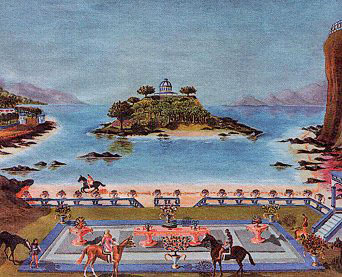 The
supposed existence of a destroyed civilization pre-dating Egypt and
Sumer falls into two categories: the fabled existence of
Atlantis,
as described by Plato, and the intervention of space-faring gods, or
‘ancient astronauts’. The
supposed existence of a destroyed civilization pre-dating Egypt and
Sumer falls into two categories: the fabled existence of
Atlantis,
as described by Plato, and the intervention of space-faring gods, or
‘ancient astronauts’.
Both schools of thought have a spectrum of advocates, (and many
detractors), and both theories call for advanced technology and
scientific knowledge among a lost ancient people in both cases.
Traces of that knowledge are thought to have passed down by oral
tradition, anomalous material evidence and through the careful and
detailed construction of ancient monuments.
It seems eminently plausible to me that a working scientific
knowledge of remote Natural History of our Earth would have been
understood by either Atlanteans or, even more likely,
the Anunnaki.
In the case of the latter, the Anunnaki are described as having a
keen interest in mining for gold
(4),
beginning in Africa and
probably extending to South America. It does not seem beyond the
realm of possibility that dinosaur bones were excavated, studied and
perhaps collected. Thus, a technologically advanced race of humans
in antiquity may have known of the dinosaurs, and that knowledge may
have filtered down to ancient peoples after the Cataclysm through
dragon-based myths and the like.
Perhaps, then, the Ica Stones were created by ancient Peruvian
peoples based upon an inherited knowledge of the Earth’s Natural
History. We could then rule out the existence of dinosaurs still
roaming the Earth in living memory (which seems unlikely,
although
not entirely impossible) and the idea, promulgated unsuccessfully by
Dr Cabrera, that the Ica Stones stand as a unique testament to the
very remote existence of humanity many millions of years ago.
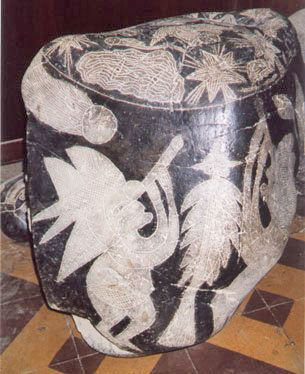
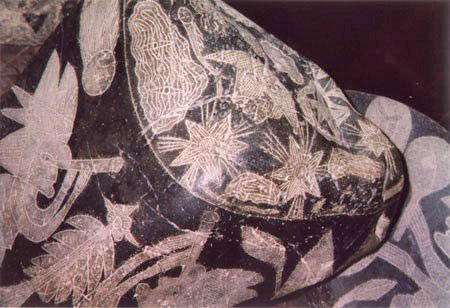
So what of the particular example
highlighted by the researcher Kathy Doore, shown above? If they are
genuine, ancient Ica Stones created by the indigenous people of Peru
hundreds, possibly thousands of years ago, then do they point to the
existence of the ‘True Sun of the Incas’? This Ica Stone has several
fascinating features. Firstly, the Andeans pictured appear to be
looking up at the heavens using telescopes. One would imagine this
to be utterly impossible for the ancient Incas; a certain mark of
fakery surely?
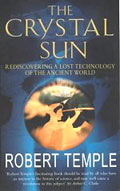 Well,
things are never quite as straightforward as they first appear.
Robert Temple, the author of ’The Sirius Mystery’, wrote a book
about the unrecognized collections of ancient lenses in various
museum collections around the world, entitled ’The Crystal Sun’
(6).
The lenses had been discovered by archeologists for generations and
dutifully handed over to disinterested antiquarians for display in
various museums. His book makes a strong case for the widespread
use
of lens in the ancient world, and even proposes the use of
telescopes, as can be seen from the shard of Greek pottery that
adorns the front cover of his book (click
image right). Well,
things are never quite as straightforward as they first appear.
Robert Temple, the author of ’The Sirius Mystery’, wrote a book
about the unrecognized collections of ancient lenses in various
museum collections around the world, entitled ’The Crystal Sun’
(6).
The lenses had been discovered by archeologists for generations and
dutifully handed over to disinterested antiquarians for display in
various museums. His book makes a strong case for the widespread
use
of lens in the ancient world, and even proposes the use of
telescopes, as can be seen from the shard of Greek pottery that
adorns the front cover of his book (click
image right).
 Temple does not describe examples from South America, but there are
famous examples of worked rock crystal from Meso-America. I have in
mind, of course, the Mitchell-Hedges Crystal Skulls.
(click image left) Temple does not describe examples from South America, but there are
famous examples of worked rock crystal from Meso-America. I have in
mind, of course, the Mitchell-Hedges Crystal Skulls.
(click image left)
It is not a big leap from these incredible artifacts to working rock
crystal into lenses to be used by the Incas, and thus featuring on
an Ica Stone.
Furthermore, tantalizing evidence for the existence of ancient
lenses in South America is recorded by Harold T. Wilkins in 1945.
Wilkins was born in 1891 in my own home city of Gloucester, and may
even have attended the same grammar school there. During his
extensive researches in South America before World War II he met Señor Muñoz, a
haciendero who owned an estate on the seashore not
far from Guayaquil, Equador. Harold Wilkins relates this remarkable
tale, alluding to the possibility of the finds being linked to a
lost continent in the Pacific Ocean:
“He [Señor Muñoz] set a diver to fish up statuettes from a drowned
and very ancient city lying under water just off shore. The diver
came up with artistic statuettes of men and women whose hair was
dressed in very Egyptian fashion! They had the same curiously long
slanted eyes as you find in frescoes in the tombs of the Pharoahs.
On their breasts were jewels carved in stone. The dead and ancient
civilization must have been very, very old; for some of the
statuettes are pornographic – a sign that the makers are of a race
that has lapsed from a higher state of culture.
“As said Muñoz to me: “Señor
Wilkins, it may amaze you to hear that
every race in the world is represented in these statuettes, so
incredibly ancient, found under water by my diver. There are Aryans,
Semites, Caucasians, and even a race remarkably like the modern
Japanese! The race had seals like prisms, covered with hieroglyphs.
Also, I have found ancient convex lenses, under water, there, and
also reflectors. They were made of obsidian… they must have been
scientific opticians, even astronomers.””
(7)
So perhaps we would do well to keep an open mind on the potential
for ancient optical technology in the Andes. Of course, this is not
the only remarkable feature of Kathy’s Ica Stone. The centre-point
of the heavens pictured on the stone is an odd-shaped feature, not
unlike an upturned boat! Perhaps a celestial barge, like the ones
often featured by the ancient Egyptians? This celestial barge is
accompanied by clouds, meteors and stars. Additionally, below the
celestial canopy is a huge comet.
But note that the Andeans are not pointing their telescopes at the
great comet, as one might expect. Instead, they are looking at that
celestial barge. So I wonder whether the ’celestial barge’ is the
return of the Dark Star Nibiru, surrounded by its halos and
companion ’stars’ (really moons). If so, then telescopes are
evidently required to see the heavenly apparition, which is itself
interesting. A point I shall pursue in my new book ’Binary
Companion’, (which I hope to finish one of these days...) The lower
and rather prominent ’comet’, or sizeable meteor, is perhaps a sign
of danger; the potential for a catastrophe associated with the
return of Nibiru.
Perhaps this is portending the end of an Age when the ’True Sun’
returns?
Of course, this all rather depends upon the authenticity of the
Ica
Stones in the first place, and this is not a question that will be
answered soon, if ever. Archeologists have no interest in these
stones whatsoever, having assumed from the start that they must be
fake. But the context of this particular Ica Stone is certainly
consistent with a body of evidence about the Dark Star, the ’True
Sun’, that is continuing to build from various sources, both
mythological and scientific.
Update 12/1/05:
A Peruvian Binary Circle
Greg Jenner has come across an example of a binary sun circle at
Sillustani in Peru that presumably pre-dates the Incas. The circles
are of unequal size with the largest circumscribed by a platform of
hewn stones. This larger circle also has a single upright stone
placed within it, as described in an account by E.G. Squier in
’American Naturalist (1870):
"In connection with the group of
chulpas at Sillustani
(click below map), or rather on the same promontory on which
these occur, are found a number of such Sun-circles, which seem
strangely to have escaped the notice of travellers. The
tradition of their original purpose is preserved in the Quichua
name they still bear of Intihuatana, ’where the sun is tied up’.
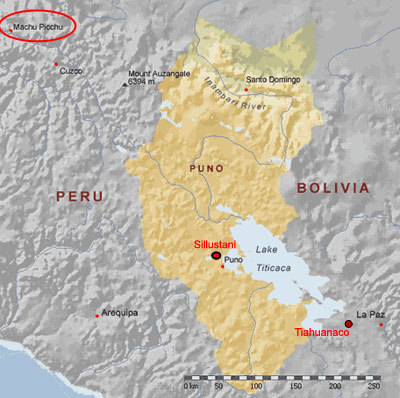
"Some of these circles are more
elaborate than others, as shown in the engraving, from which it
will be seen that while the one nearest the spectator is
constructed of simple upright stones, set in the ground; the
second one is surrounded by a platform of stones more or less
hewn and fitted together. The first circle is about 90’ in
diameter; the second about 150’ (see below
image), and has a single erect stone
standing in the relative position I have already indicated. A
remarkable feature in the larger circle is a groove cut in the
platform around it, deep enough to receive a ship’s cable."
(9)
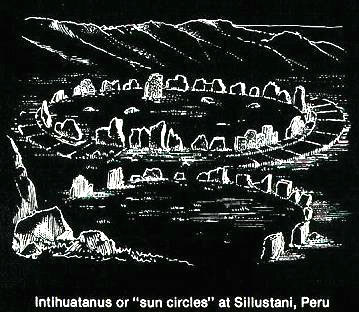
It seems peculiar that there should be
2
suns denoted by these circles. If this is an example of an early
observatory, like Stonehenge in England or the Medicine Wheels of
North America, then one would expect a single circle, with the
interior standing stone acting as a viewing marker. Two circles
logically imply two suns; a binary star system that was understood
by the ancient Peruvians. Remarkably, a similar binary solar circle
can be found at Avebury in England
(see below).
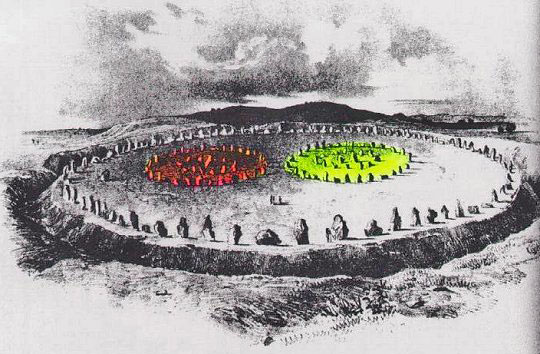
I have scant information about these
standing stones, but it seems logical that the single stone within
the larger circle is an archeo-astronomical marker of some kind.
However, a further possibility exists.
In a binary system the centre of gravity of the solar system would
be shifted away from the exact centre of the Sun. Does this stone
provide an approximate location for the centre of the solar system,
thus enabling us to ascertain the approximate whereabouts of a
sub-brown dwarf companion? Whether or not this is the case, the fact
that such a binary solar circle exists in Peru is further supportive
evidence that the ancient people of this area maintained a tradition
of knowledge that is now, perhaps, lost: a secret knowledge of
Nibiru.
References
2) K. Doore (Ed); ‘Excerpts from “The Message of the
Engraved Stones of Ica” by Javier Cabrera’
www.labyrinthina.com
3) M. Baigent “Ancient Traces” pp18-20, Penguin 1998
4) Z. Sitchin “The Twelfth Planet” Avon 1976
5) A. Cotterell (Ed) "Encyclopedia of World Mythology"
PP294-9 Parragon 1999
6) R. Temple "The Crystal Sun" Century 2000
7) H.T. Wilkins “Mysteries of Ancient South America”
pp19-20, Rider & Co, London 1945
8) Zoltan Andrew Simon ‘Atlantis: The Seven Seals.’
Robinson Expeditions Publishing in Vancouver, B.C. 1983. With
thanks to Greg Jenner
9) "The Primeval Monuments of Peru compared with those in
other parts of the World". Squier, E.G., American Naturalist,
4:1-17, 1870 (obtained by Greg Jenner from William R. Corliss’
book "Ancient Man: A Handbook of Puzzling Artifacts" 1978, p140)
Interesting correspondence:
Andy,
Spanish is my mother tongue so please se te paciente conmigo
cuando te escribo en inglés (pls. be patient with me when I
write you in English).
Admirable your work -congratulations. But for it to have the
impact it needs to have I suggest that you modify your East to
West perspective and turn it the other way around as it should
be. Let me explain myself.
Your hypothesis will be highly enriched when you accept what I
call the "West to East Ancient Knowledge Flow "
hypothesis (some
know it as the "Aliaga7 Ancient Knowledge Flow Hypothesis)."
Concretely (besides proposing as early as 1999 that Nibiru is
actually Aymaru, that Enki is Incay and that
Anu is Allu, and
that in the
Fuente Magna dish the archeologists are wrongly
interpreting POTAKAI because on time it will shown it means
UTA.KI -home on earth), most importantly I am one of the two
more serious proponents in the world of the hypothesis that
ancient knowledge went from South/Central America to the Middle
East more than the other way around.
The other proponent of the same hypothesis is my close friend
and colleague, the brilliant British explorer, Jim Allen (author
of "Atlantis the Andes Solution" and of "The Atlantis Trail").
By practically having demonstrated that Atlantis was
South
America and the its capital of the same name was in the south of
the Bolivian Altiplano, Jim obviously has contributed lots to
support the hypothesis that the flow of knowledge - and
civilization at its dawn - mainly went from the West to the Near
East instead of the other way around as wrongly currently
assumed by most.
I have proposed the same but not from the Atlantis perspective
as Jim has done so. Instead, I proposed this based on the work
of the great Bolivian (from Sorata) Poliglot and Lord Behring
disciple, the late Emeterio Villamil De Rada who was the most
serious Aymarologists (and historians) perhaps of all times.
But the most important proof for this is that in Egyptian
mummies traces of COCA leaves were found. And this is crucial
because coca is not only native to the East side of the South
American (mainly Bolivia’s and Peru’s) Andes but also
practically endemic -therefore coca COULD ONLY HAVE FLOWED from
South America (i.e.d, historic Atlantis -or even where the
Olympus/Illampus were) to Egypt.
I assure you that as soon as you start using the above mentioned
hypothesis, your "Dark Star Theory" will be accepted, for the
benefit of all of humanity and the biosphere...
Best regards,
Carlos Aliaga Uria
Back to Contents
|


 The
supposed existence of a destroyed civilization pre-dating Egypt and
Sumer falls into two categories: the fabled existence of
The
supposed existence of a destroyed civilization pre-dating Egypt and
Sumer falls into two categories: the fabled existence of






